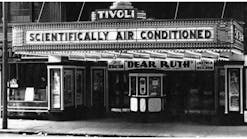At the Buck Institute for Research on Aging in Novato, Calif., an independent biomedical research facility focused on the connection between aging and chronic disease, the priorities are clear.
“As a nonprofit entity working toward notable advancements in aging medicine, we want to keep our operational costs down so we are able to focus funding on actual scientific research,” Ralph O’Rear, vice president of facilities and planning, said.
As it prepared to embark on a 60,000-sq-ft expansion of its 185,000-sq-ft research facility, the Buck Institute sought a HVAC solution that not only could provide added capacity, but would optimize energy efficiency, minimize overall consumption, and reduce total cost of ownership. With the facility running on 100 percent single-pass outdoor air and requiring six air changes per hour—any HVAC-component downtime would require a complete shutdown of the facility—the Buck Institute needed a solution that also would minimize downtime—both during construction and post-occupancy—with built-in redundancies.
To address these needs, the Buck Institute facility-management team commenced a three-part evaluation that began with an in-depth analysis of energy consumption. The team then looked for immediate and minimally invasive methods of reducing energy use, such as adding motion-sensing lighting systems, installing variable-frequency drives on motors in the central plant, purchasing ENERGY STAR-rated electrical devices and equipment, and performing high-energy-use tasks during off-peak hours. This culminated in the development of a campuswide cooling technique and central-plant plan involving consideration of new technologies in solar, wind, coal, cogeneration, and geothermal exchange.
The evaluation of the existing system showed the cooling load created substantial energy demand. As a result, the team sought a new geothermal-exchange ground-loop system to better manage load requirements. The loop acts like a battery for heat throughout the year. Condenser water is piped into the ground. The ground absorbs heat from the water during summer and returns heat to the system during winter, when a modular chiller is in heating mode and uses condenser water as its heat source. This balancing effect throughout the year equates to a notable overall reduction in the amount of energy required for cooling.
Increased Efficiency, Reduced Cost of Ownership
The Buck Institute’s new HVAC solution, designed by Portland, Ore.-based PAE Engineers, and interior mechanical system, installed by Sacramento, Calif.-based Lawson Mechanical Contractors, took advantage of the facility’s existing cooling tower and 500-ton centrifugal chiller. The team added two 70-ton water-cooled, cooling-only modular chillers and four 70-ton simultaneous-heating-and-cooling heat-recovery modular chillers from ClimaCool Corp., which were fed by a newly installed geothermal-exchange ground-loop system. Heat recovery was used as part of the modular-chiller configuration to further equalize the temperature range and reduce the energy required in heating mode.
Unlike traditional modular chillers, ClimaCool chillers have the ability to heat as well as cool by recovering heat from a cooling module to increase the overall energy efficiency of a system.
“Why throw away the heat when new modular-chiller technologies enable you to recover and harness it?” Ross Miglio, president of ClimaCool, asked. “The Buck Institute’s need for simultaneous heating and cooling fits our modular-chiller design. This level of flexible design provides a number of ways to lower your cost of ownership that you can’t achieve with any other modular chiller.”
For the Buck Institute, this level of flexibility affords the opportunity to cover a cooling-load range of 35 to 320 tons in energy-efficient stages and turn over the load to the secondary system—the 500-ton centrifugal chiller—when needed.
The modular management of load demand allows the Buck Institute to make only as much chilled water as needed to meet the load and improve the turndown capacity. The ClimaCool units have a bank that is used to take heat from the return-water loop and redistribute it for other applications, such as domestic hot water. Facility managers can dial up the bank on peak days or dial it down to power just one or two units, using only the energy needed.
“We chose ClimaCool’s chiller bank because it required a smaller physical footprint, allowing us to get additional modular chillers for added capacity into our existing space,” O’Rear explained. “The geothermal loop and modular chillers are our primary system for most of the year. In California, we get 30 to 40 days of really intense heat each year, and that’s when we utilize the secondary system to meet the additional load requirements.”
Elimination of Downtime and Reduction of Maintenance
This level of flexible configuration was one of many unexpected benefits of the modular-chiller design. Additionally, the separate module electrical feeds and dual independent refrigeration circuits for individual units facilitate ease of maintenance; the repair of a module does not require shutdown of the entire system.
O’Rear’s team is able to isolate modules for maintenance while keeping the others running, minimizing risk to research efforts. Additionally, the team is able to perform preventive and routine maintenance in-house with easy access to common components.
The new HVAC system has provided the Buck Institute with load and supply matching for vastly improved efficiency, O’Rear said.
“After increasing our total facility footprint by more than 30 percent, our operating expenses have remained the same as they were for our original square footage, and we saved about $150,000 per year in utility expenses,” O’Rear said.
For Design Solutions author guidelines, call Scott Arnold, executive editor, at 216-931-9980, or write to him at [email protected].











